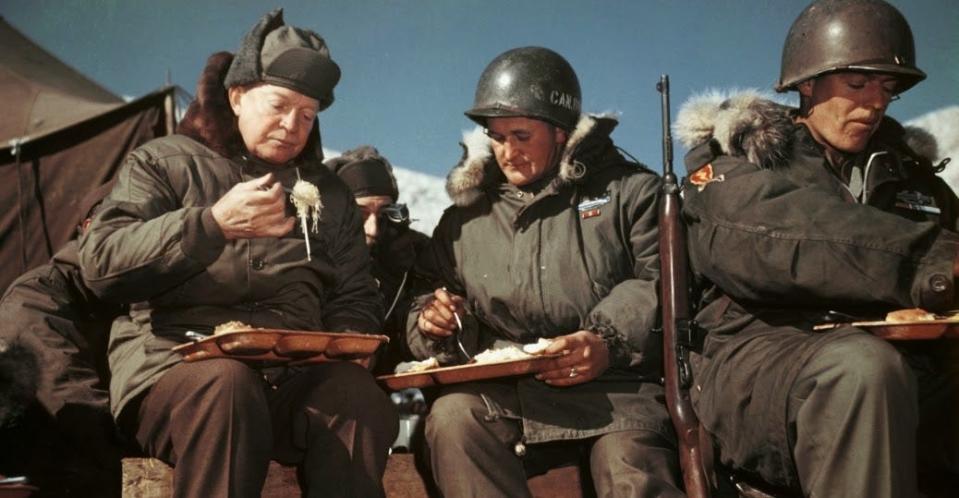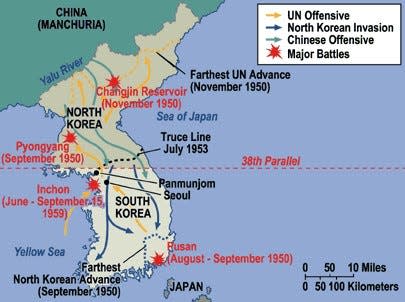Remembering Korea part III: Small attacks, negotiations, armistice and aftermath
- Oops!Something went wrong.Please try again later.
- Oops!Something went wrong.Please try again later.
(This is the last of a three-part series marking the 70 year anniversary of the signing of the armistice in Korea on July 27, 1953.)
With neither side proving capable of military victory, the U.S. led United Nations Command (UNC) and the Chinese-North Korean alliance began truce talks as early as 1951. The Police Action would continue on. Why the term Police Action? The U.S. Congress never formally declared war on North Korea, China or the Soviet Union. While the U.S. supplied 90% of the troops, 22 other countries either contributed combat or medical assistance. They were all under the auspices of the United Nations. Since the UN itself cannot declare war, it declared this a Police Action.
From July 1951 to July 1953, the fighting continued, by settling into a military stalemate. Essentially, it was a stalemate between the three superpowers, the U.S., China and the Soviet Union. The war remained focused on gaining and losing ground near the 38th parallel where the war began. The two forces were constantly bombarding each other along the front. The U.S. possessed a large advantage in weapons, firepower (roughly 5:1) and air superiority, while the China-North Korean forces held a large advantage in the number of troops. While full-scale battles dwindled, major and minor skirmishes would not cease until the Armistice was signed.
The fall of 1952 saw several smaller, but deadly battles. The Battle of Old Baldy was a series of engagements for Hill 266 in west-central Korea that lasted nearly 10 months. Several battalions on both sides looked to take the high ground. Old Baldy, which was one of the most prominent of a series of hills, earned its nickname due to the lack of trees and vegetation after constant artillery and mortar fire. It was the most important hill because it dominated the terrain in three directions. The battle lasted until March 26, 1953, with the UN suffering 357 losses and China losing 1,100.

The Battle of White Horse was fought between Oct. 6-15, 1952. White Horse was so-named for the crest of one of the hills in the Yokkok-chon Valley. During 10 days of battle, the hill changed hands 24 times. It was a microcosm of the struggle to gain ground during the three years of the war. The losses were much heavier during this prolonged struggle, with 3,500 UN losses and an estimated 10,000 Chinese losses.
The Battle of Triangle Hill or Operation Showdown saw the UN forces, with support from the U.S. Air Force, against China’s 12th and 15th Corps. This battle was part of the American forces plan to control the so-called “Iron Triangle”. The Iron Triangle was a key communist communications junction located between Cheorwon and Pyongyang in the north. The area 20-30 miles north of the 38th parallel saw heavy fighting between the Chinese and the U.S. Eighth Army from October – November 1952.
On the home front, President Harry S Truman saw a rapid decline in popularity as his rating fell to a mere 22 percent as the 1952 presidential primaries drew near. Without the support of the Democratic Party, Truman declined to seek another term on March 29, 1952. His firing of WWII hero, Gen. Douglas McArthur was also a contributing factor. Truman would be the last president eligible to run for more than two terms. Republican majorities in the House and Senate passed a constitutional amendment in 1947 saying that “no person shall be elected to the office of president more than twice.”
On Nov. 4, 1952, Gen. Dwight D. Eisenhower, the former Supreme Commander of Allied Forces during WWII, won a landslide victory over Democrat Adlai Stevenson. Eisenhower’s campaign pledge was to bring an end to the conflict in Korea. He made the startling statement, “If elected, I shall go to Korea.” Acting on this campaign pledge, Eisenhower went to Korea on Dec. 1, 1952. While there, the old soldier did what he did best - he visited the U.S. troops, their commanders, South Korean leaders and received briefings on the military situation in Korea. He astutely observed, “Small attacks on small hills would not end this war.”
After Eisenhower’s visit, the negotiating and the fighting would continue on into 1953. One of the “small attacks on small hills” was Pork Chop Hill, west of the above mentioned Iron Triangle, from March–July 1953. During the two main battles for the hill, UN casualties stood at over 1,300 casualties with China and North Korea suffering over 4,000 casualties. One of the last battles of the Korean War was the Battle of Kumsong. South Korean forces refused to participate in peace negotiations, so the Chinese forces launched an attack along the Kumsong River and defeated the ROK forces. After an ROK counterattack, the Korean Armistice Agreement was finally signed on July 27, 1953, by the United States, North Korea and China. South Korea did not agree to sign, objecting to the continued division of Korea.
One of the main sticking points in getting a signed armistice in Korea centered around prisoners of war (POW’s). Even before the peace agreement was signed, both sides agreed to exchange sick and wounded prisoners. Levelland resident Alton Garner escaped the draft until April 1952 and was inducted into the U.S. Marines. Assigned to the 1st Medical Battalion, Alton was stationed west of Seoul in late 1952. In late April 1953, several Marines from the battalion were chosen to go to “Freedom Village” at Panmunjom where the UN prisoners were to be exchanged for communist prisoners from China and North Korea. Alton recalled that “Most of the (UN) prisoners were clothed in either Russian or Chinese clothing. All the men seemed to have been brainwashed and one of them said he 'had spent 1,001 days in captivity.'” The men were part of Operation Little Switch and Operation Big Switch. The exchanges lasted from April 20 through December 1953. The exchange saw nearly 796,000 communist prisoners and 13,000 UN prisoners exchanged (8,000 South Korean, 3,600 Americans and nearly 1,000 British). Nearly 23,000 communist soldiers declined repatriation. Twenty-one Americans, one Briton and 325 South Korean soldiers also declined repatriation.
By the time the shooting ended, South Korea had lost 10% of its pre-war population of nearly 21 million. Scholars have noted that the rate of civilian casualties in Korea was higher than in WWII or the Vietnam War, with 2 million to 3 million perishing. Virtually all of the major cities were destroyed. South Korea was slow to recover the first eight years after the war. They were ranked among the poorest nations in the world after the war. After years of struggle and change, South Korea finally transitioned from an authoritative military state (1948-1987) to a liberal democratic state in 1988.

South Korea is now a thriving nation of a little over 51 million inhabitants. Some of the largest companies in South Korea that export to the U.S. are the Samsung Group, LG, Hyundai Motor and KIA to name a few. They are America’s sixth largest trading partner. Why was the Korean War important? It was important to not only the U.S. and South Korea, but for democracy around the globe. This is why we should remember and honor those who sacrificed during the so-called Cold War. We continue to be vigilant against North Korean provocations to this day.
This article originally appeared on Lubbock Avalanche-Journal: Korean War part 3 small attacks, negotiations, armistice and aftermath

